| THE GRAND SUBVERSION, |
|
[
HOME ]
|
|
Internal Link |
Ruby Page.
|
Ruby and Oswald Were Not Acquainted
The possibility of a prior acquaintanceship between Ruby and Oswald has been suggested by some persons who viewed the shooting on television and believed that a look of recognition appeared on Oswald's face as Ruby moved toward him in the jail basement. The Commission has examined the television tapes and movie films which were made as Oswald moved through the basement and has observed no facial expressions which can be interpreted as signifying recognition of Ruby by Oswald. It is doubtful even that Oswald could have seen Ruby sufficiently clearly to discern his identity since Oswald was walking from a dark corridor into "the flash from the many cameras" and the lights of TV cameramen which were "blinding." In addition to such generalized suspicion, there have been numerous specific allegations that Oswald was seen in the company of Ruby prior to November 22, often at Ruby's Carousel Club. All such allegations have been investigated, but the Commission has found none which merits credence. In all but a few instances where the Commission was able to trace the claim to its source, the person responsible for the report either denied making it or admitted that he had no basis for the original allegations. Frequently those responsible for the allegations have proved to be persons of erratic memory or dubious mental stability. In a few instances, the source of the story has remained unidentified, and no person has come forward to substantiate the rumor.
The testimony of a few witnesses who claim to have seen Ruby with a person who they feel may have been Oswald warrants further comment. One such witness, Robert K. Patterson, a Dallas electronics salesman, has stated that on a date established from sales records as November 1, 1963, Ruby, accompanied by a man who resembled Oswald, purchased some equipment at his business establishment. However, Patterson did not claim positively that the man he saw was Oswald, and two of his associates who were also present at the time could not state that the man was Oswald. Other evidence indicates that Ruby's companion was Larry Crafard. Crafard, who lived at the Carousel Club while working for Ruby from mid-October until November 23, 1963, stated that sometime in late October or early November he accompanied Ruby to an electronics store in connection with the purchase of electronics equipment. Ruth Paine testified that Crafard's photograph bears a strong resemblance to Oswald; and employment records of the Texas School Book Depository show that Oswald worked a full day on November 1, 1963.
William D. Crowe, Jr., a young nightclub master of ceremonies who had worked for Ruby on three occasions and had begun a 4- or 5-week engagement at the Carousel Club on November 11, 1963, was the first person who reported a possible association between Ruby and Oswald. While attempting to enter the Carousel Club on November 24, shortly after Oswald was shot, Crowe encountered two news media representatives who were gathering information on Jack Ruby. At that time, Crowe, who included a memory act in his repertoire, mentioned the "possibility" that he had seen Oswald at the Carousel Club. As a result he was asked to appear on television. In Crowe's own words, the story "started snowballing." He testified:
They built up the memory thing and they built up the bit of having seen
Oswald there, and I never stated definitely, positively, and they said that I
did, and all in all, what they had in the paper was hardly even close to what I
told them.
▲
Crowe added that his memory act involved a limited system which did not, in fact, improve his memory and that his memory might not even be as good as that of the average person. When asked how certain he was that the man he saw was Oswald, Crowe testified: "...the face seemed familiar as some faces do, and I had associated him with a patron that I had seen in the club a week before. That was about it."
A possible explanation for Crowe's belief that Oswald's face seemed familiar was supplied by a freelance photographer, Eddie Rocco, who had taken pictures at the Carousel Club for Ruby at about the time Crowe was employed there. Rocco produced one of those photographs which depicted a man who might have been mistaken for Oswald by persons having no reason to remember the man at the time they saw him. When shown the Rocco photograph, Crowe said that there was as strong a possibility that the man he recalled seeing was the man in the photograph as there was that he was 0swald. Crowe's uncertainty was further underscored by his failure initially to provide his information about Oswald to David Hoy, a news-media friend whom Crowe telephoned in Evansville, Ind., less than 20 minutes after Oswald was shot. By then the possible recognition had occurred to Crowe, and Hoy said he was quite surprised that Crowe had given the information first to other news representatives instead of telling him in that early conversation.
After Crowe's identification had been publicized, four other persons also reported seeing Oswald at the Carousel Club. One man said he saw Ruby and Oswald seated at a table together and recalled that the man resembling Oswald was addressed by a blond-haired waitress as "Bettit" or "Pettit." The witness was unable to give any description of "Pettit" except that he was the man who had been shot by Ruby. He could not describe the inside of the Carousel and was unable to give a precise location for the club. Another witness, a resident of Tennessee, related seeing a man resembling Oswald at the Carousel Club on November 10. Ruth Paine has testified, however, that Oswald spent the entire holiday weekend of November 9, 10, and 11 at her home in Irving, Tex. Two of Ruby's former employees, Karen Carlin and Billy Joe Willis, also believed they had seen a person who resembled Oswald. Willis believed he saw the man at the Carousel Club but did not think the man was Oswald. Mrs. Carlin likewise was not certain that the man was Oswald nor was she sure where she had seen him. Neither reported any connection between the man and Ruby. No other employees recalled seeing Oswald or a person resembling him at the Carousel Club.
Wilbryn Waldon (Robert) Litchfield II also claimed to have seen at the
Carousel Club a man resembling Oswald. Litchfield stated that during a visit to
the Carousel Club in late October or early November 1963, he saw such a man
enter Ruby's office, apparently to confer with Ruby. Although there is
substantial evidence that Litchfield did see Ruby at the Carousel Club about
that time, there is strong reason to believe that Litchfield did not see Lee
Harvey Oswald. Litchfield described the man he saw as having pockmarks on the
right side of his chin; Oswald did not have such identifying marks. Moreover,
the Commission has substantial doubts concerning Litchfield's credibility.
Although present at an FBI interview of another witness on November 29,
Litchfield made no mention of his observation to public officials until December
2, 1963. Litchfield, who had twice been convicted for offenses involving forged
checks, testified that he first recalled that Oswald resembled the visitor he
saw at the Carousel Club while watching a television showing on Sunday morning,
November 24, of the shooting by Ruby. At that time Litchfield was playing poker
with three friends, and he testified that he promptly informed them of the
resemblance he observed. However, none of the three poker companions remembered
Litchfield's making such a remark; and two added that Litchfield's statements
were often untrustworthy.
▲
With regard to all of the persons who claimed to have seen Ruby and Oswald
together, it is significant that none had particular reason to pay close
attention to either man, that substantial periods of time elapsed before the
events they assertedly witnessed became meaningful, and that, unlike the
eyewitnesses who claimed to have seen Oswald on November 22, none reported their
observations soon after Oswald was arrested. In the course of its investigation,
the Commission has encountered numerous dear mistakes of identification. For
example, at least four persons, other than Crafard, are known to have been
mistaken for Oswald. Other persons have been misidentified as Jack Ruby. Under
all the available evidence there is no substantial likelihood that the person
the various witnesses claimed to have seen with Ruby was in fact Oswald.
In addition to probing the reported evidence that Ruby and Oswald had been seen together, the Commission has examined other circumstances for signs that the two men were acquainted. From the time Oswald returned from Mexico, both he and Jack Ruby lived in the Oak Cliff section of Dallas, slightly more than a mile apart. Numerous neighbors of both Oswald and Ruby were interviewed, and none knew of any association between the two. Oswald's work began at 8 each weekday morning and terminated at 4:45 each afternoon. Jack Ruby usually remained in his apartment until past 9 a.m. each day. Although both men worked in downtown Dallas, they normally traveled to their places of employment by different routes. Ruby owned an automobile, and the shortest route downtown from his home was via a freeway adjacent to his apartment. Oswald did not own a car and had, at best, a rudimentary ability to drive. From his rooming houses on North Beckley Avenue and on Marsalis Street, he normally took public transportation which did not bring him within six blocks of either Ruby's apartment or his downtown nightclub, nor did Oswald's route from the bus stop to home or work bring him near Ruby's home or business. Persons at Oswald's rooming house testified that he regularly came home promptly after work and remained in his room. While in Dallas, he is not known to have visited any nightclub. Ruby was generally at the Carousel Club from 9 o'clock each evening until after 1 a.m. In a few instances, Ruby and Oswald patronized the same stores, but no indication has been found that they ever met at such stores. Ruby at one time frequented a restaurant where Oswald occasionally ate breakfast, but the times of their patronage were widely separated and restaurant employees knew of no acquaintance between Ruby and Oswald. Likewise, Ruby has held various memberships in the Dallas YMCA and Oswald lived there for brief periods; however, there is no indication that they were there at the same time.
Both Ruby and Oswald maintained post office boxes at the terminal annex of the U.S. post office in Dallas, but there is no indication that those facts were more than coincidental. On November 1, 1963, Oswald rented box No. 6225, his third since October 1962. Oswald's possible purpose has been discussed previously in this chapter. On November 7, 1963, Jack Ruby rented post office box No. because he hoped to receive mail responses to advertisements for the twist board exercise device which he was then promoting. Although it is conceivable that Oswald and Ruby coincidentally encountered one another while checking their boxes, the different daily schedules of the two men render even this possibility unlikely. Moreover, Oswald's withdrawn personality makes it improbable that the two would have spoken if their paths had crossed.
The Commission has also examined the known friends and acquaintances of Ruby
and Oswald for evidence that the two were acquainted, but it has found very few
possible links. One conceivable association was through John Carter, a boarder
at 1026 North Beckley Avenue while Oswald lived there. Carter was friendly with
Wanda Joyce Killam, who had known Jack Ruby since shortly after he moved to
Dallas in 1947 and worked for him from July 1963 to early November 1963. Mrs.
Killam, who volunteered the information about Carter's residence during an
interview with an agent of the FBI, has stated that she did not believe Carter
ever visited the Carousel Club and that she did not think Carter knew Ruby.
Carter slated that he had not heard of Ruby until Oswald was shot, had talked
briefly with Oswald only once or twice, and had never heard Oswald mention Ruby
or the Carousel Club. The Commission has no reason to disbelieve either Mrs.
Killam or Mr. Carter.
▲
A second possible link between Oswald and Ruby was through Earlene Roberts, the housekeeper at North Beckley Avenue. Bertha Cheek, the sister of Mrs. Roberts, is known to have visited Jack Ruby at the Carousel Club during the afternoon of November 18, 1963. Mrs. Cheek testified that she had met with Ruby and a person whom Ruby represented to be an interior decorator for the purpose of discussing the possibility of financially backing Ruby in a new nightclub which he planned to open. Mrs. Cheek said she had met Ruby only once, a few years before, and that she had not heard of Oswald until he shot President Kennedy. Mr. Frank Boerder, the decorator who was present at the November 18 meeting, confirmed the substance of the discussion reported by Mrs. Cheek, and other witnesses establish that Ruby was, in fact, seeking an associate for a new nightclub venture. There is no evidence that Jack Ruby ever associated with Earlene Roberts, nor is there any indication that Mrs. Cheek knew of Lee Harvey Oswald prior to November 22.
Oswald's trips to the home of Mrs. Ruth Paine at 2115 West Fifth Street in Irving, Tex., presented another possible link to Ruby. While Oswald's family resided with Mrs. Paine, William F. Simmons, piano player in the musical combo which worked at the Carousel Club from September 17, 1963, until November 21, 1963, lived at 2539 West Fifth Street, in Irving. Simmons has stated that his only relationship to Ruby was as an employee, that Ruby never visited him, that he did not know Oswald, and that he had never seen Oswald at the Carousel Club. Other persons in the neighborhood knew of no connection between Ruby and Oswald.
The Commission has investigated rumors that Jack Ruby and Lee Harvey Oswald were both homosexuals and, thus, might have known each other in that respect. However, no evidence has been uncovered to support the rumors, the closest acquaintances of both men emphatically deny them, and Ruby's nightclubs were not known to have been frequented by homosexuals.
A final suggestion of a connection between Jack Ruby and Lee Harvey Oswald arises from the testimony of Oswald's mother, Marguerite Oswald. When appearing before the Commission, Mrs. Oswald related that on November 23, 1963, before Ruby shot Oswald, FBI Agent Bardwell D. Odum showed her a picture of a man she believed was Jack Ruby, and asked whether the man shown was familiar to her. Odum had first attempted to see Marina Oswald, but Marguerite refused to allow Marina to be disturbed at that time. In the course of Marguerite's testimony, the Commission asked the FBI for a copy of the photograph displayed by Odum to her. When Marguerite viewed the photograph provided the Commission, she stated that the picture was different from the one she saw in November, in part because the "top two corners" were cut differently and because the man depicted was not Jack Ruby.
The Commission has investigated this matter and determined that Special Agent Odum did show a picture to Marguerite Oswald for possible identification but that the picture was not of Jack Ruby. On November 22 the CIA had provided the FBI with a photograph of a man who, it was thought at the time, might have been associated with Oswald. To prevent the viewer from determining precisely where the picture had been taken, FBI Agent Odum had trimmed the background from the photograph by making a series of straight cuts which reduced the picture to an irregular hexagonal shape. The picture which was displayed by the Commission to Marguerite Oswald was a copy of the same picture shown her by Agent Odum; however, in supplying a duplicate photograph for Commission use the FBI had cropped the background by cutting along the contours of the body of the man shown, resulting in a photograph without any background, unlike the first photograph Marguerite viewed on November 23. Affidavits obtained from the CIA and from the two FBI agents who trimmed the photographs established that the one shown to Mrs. Oswald before the Commission, though trimmed differently from the one shown her on November 23, was a copy of the same picture. Neither picture was of Jack Ruby. The original photograph had been taken by the CIA outside of the United States sometime between July 1, 1963, and November 22, 1963, during all of which time Ruby was within the country.
▲
JACK
Ruby Page (1).
![]() [
BACK ]
[
BACK ]
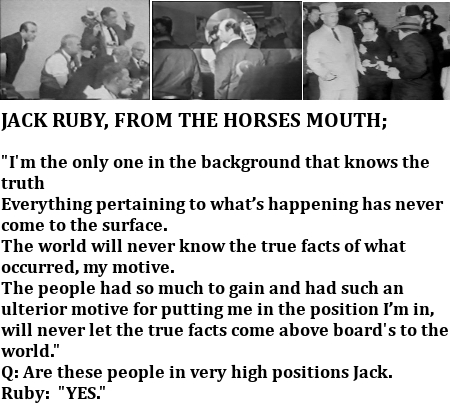
JACK RUBY SHOOTING LEE HARVEY OSWALD PHOTO CONSPIRACY JFK
ASSASSINATION JOHN F KENNEDY.
JACK
Ruby Page (1).
![]() [
BACK ]
[
BACK ]
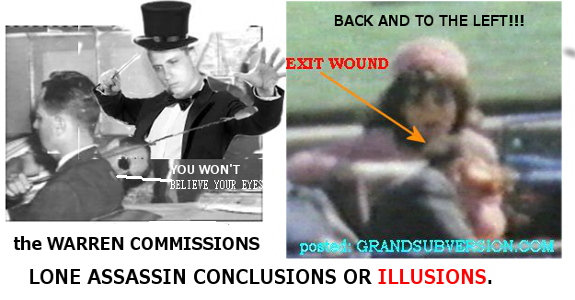
jfk assassination kennedy photo picture Warren Commission john f facts
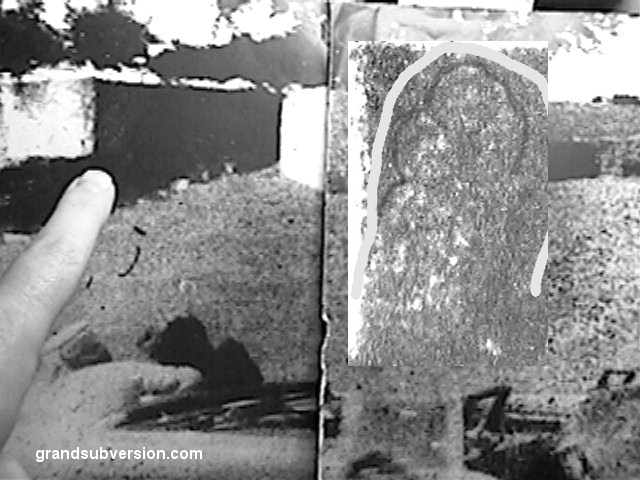
who killed jfk kennedy men who shot conspiracy theories oswald ruby
dallas police gunman grassy knoll photos.
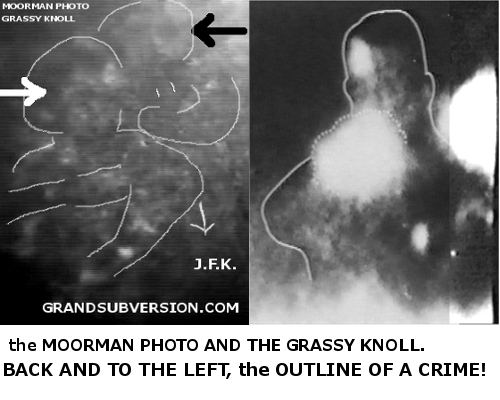
THE MEN WHO KILLED KENNEDY JFK JACK RUBY LEE HARVEY
OSWALD SHOOTING CRIME SCENE PHOTOS.
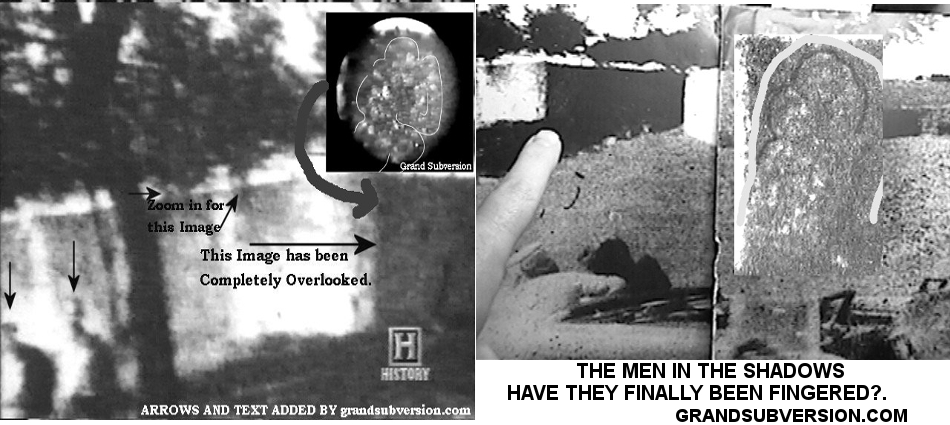
WHO KILLED KENNEDY JFK RFK MLK JR JOHN ROBERT F MARTIN KING
JFK ASSASSINATION
HOME
![]() the GRAND SUBVERSION.
the GRAND SUBVERSION.